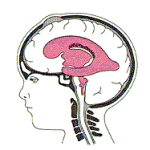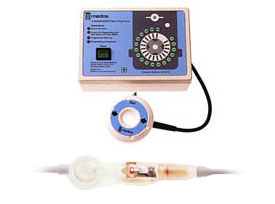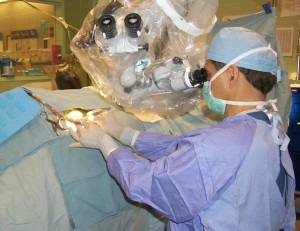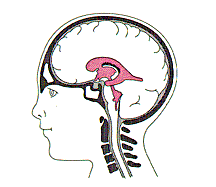Hydrocephalus
 Summary:
Summary:- Hydrocephalus results from obstruction of fluid flow through the brain cavities
- The pressure in the brain increases, causing symptoms
- Hydrocephalus can often be controlled and sometimes even cured
Hydrocephalus (from the Greek words hydro=water and cephalus=head) is an excessive build-up of cerebrospinal fluid (CSF) within the cavities of the brain (called ventricles).
Normally, new CSF is being produced on a daily basis by a bundle of blood vessels located in the ventricles. The CSF flows through the ventricles, and from there gets distributed around the brain and around the spinal cord. CSF provides nourishment and cushioning to the nerves in the brain and spine. The blood stream also reabsorbs most of the produced CSF so that the total amount of CSF remains rather constant.
Hydrocephalus results when the flow of CSF is disrupted in some way. This can be due to
- Overproduction of CSF
- Obstruction of CSF flow
- Under-absorption of CSF into the bloodstream
There are different types of hydrocephalus:
- Communicating Hydrocephalus – meaning not due to an obstruction, but due to an overproduction or under-absorption of CSF
- Non-Communicating Hydrocephalus – meaning due to an obstruction of the CSF flow.
Both of these types can be congenital (present since birth) or acquired (developed after birth as a result of e.g. head injury, tumors or meningitis).
What is the incidence of Hydrocephalus at birth?
- Hydrocephalus occurs in about 2 out of every 1000 births.
What are the symptoms of Hydrocephalus?
- Symptoms are dependent upon the age of the patient, the cause of the disruption of CSF circulation and the extent of resulting brain tissue damage.
- In newborns or infants, because their skull is not fused, accumulating fluid causes the fontanel or soft spot to swell and the entire head to enlarge. This is typically accompanied by a characteristic downward gaze.
- In older infants and children, symptoms caused by fluid build-up include headaches, nausea,vomiting, vision changes, loss of coordination and change in mental function.
- In the elderly, normal pressure hydrocephalus is more common, which presents one or more of a classic triad of symptoms: dementia, incontinence and/or gait disturbance.
The increase in CSF volume can increase the pressure in the head (intracranial pressure). This typically increases the pressure on the brain, especially in older children and adults where the skull forms a solid encasement for the brain and the CSF has nowhere to go. This can cause injury to the brain with possible long-term consequences, such as thought and behavior problems, learning disabilities and a higher risk for epilepsy.
How is Hydrocephalus diagnosed?
A number of tests and procedures are used in the diagnosis of hydrocephalus including:
- Clinical exam
- Neurological exam
- Percussion on the skull to hear sounds associated with changing bones
- Repeated measurement of the circumference of the head to show change
- Transillumination (shining a strong light) to the head to reveal CSF fluid accumulation
- CT scan to show size of the ventricles
- MRI to form images of the ventricles for evaluation
- X-rays to show thinning or separation of skull bones
- Ultrasound to outline the structures within the skull
- CSF flow studies to trace the path of CSF
What is the treatment for Hydrocephalus?
Although Hydrocephalus cannot be cured, it can be controlled. The objective of treatment is to restore proper CSF flow. A surgical procedure may be performed to divert the CSF from the ventricles in the brain to either the abdominal cavity or to a chamber in the heart called the atrium. This procedure is performed by a neurosurgeon, who implants a shunt system which consists of a flexible tube and a valve mechanism (see above). The valve mechanism regulates the flow of CSF from the ventricles. Valves are manufactured to open at a specific pressure range. The neurosurgeon selects the setting based on his evaluation of the patient. By removing the CSF from the brain, the pressure in the skull can return to normal.

Now two types of shunt systems are made, one with a single pressure setting for the valve mechanism, the other is a programmable valve system is available from Codman, a Johnson & Johnson company. The CODMAN HAKIM Programmable Valve allows the neurosurgeon to adjust the pressure setting non-invasively using a magnetic device (see blue programmer above).




 Dr. Maroon received an athletic scholarship to Indiana University in Bloomington, Indiana where as an undergraduate, he was named a Scholastic All-American in football. Dr. Maroon has successfully maintained his personal athletic interests through participation in 9 marathons and more than 72 Olympic-distance triathlon events. However, his greatest athletic accomplishment is his participation in 8 Ironman triathlons (Hawaii – 1993, 2003, 2008, 2010, 2013; Canada – 1995; New Zealand – 1997; Germany – 2000), where he usually finishes in the top 10 of his age group. Recently, in July 2012 and 2013, he finished second and third, respectively, in his age group in the Muncie, Indiana half Ironman triathlon. In October 2013 he completed his 5th World Championship Ironman in Kona, Hawaii.
Dr. Maroon received an athletic scholarship to Indiana University in Bloomington, Indiana where as an undergraduate, he was named a Scholastic All-American in football. Dr. Maroon has successfully maintained his personal athletic interests through participation in 9 marathons and more than 72 Olympic-distance triathlon events. However, his greatest athletic accomplishment is his participation in 8 Ironman triathlons (Hawaii – 1993, 2003, 2008, 2010, 2013; Canada – 1995; New Zealand – 1997; Germany – 2000), where he usually finishes in the top 10 of his age group. Recently, in July 2012 and 2013, he finished second and third, respectively, in his age group in the Muncie, Indiana half Ironman triathlon. In October 2013 he completed his 5th World Championship Ironman in Kona, Hawaii.
